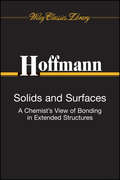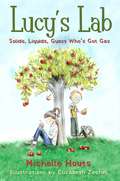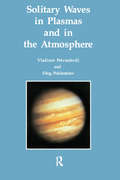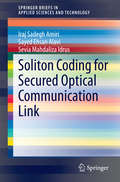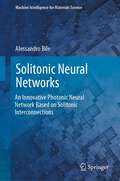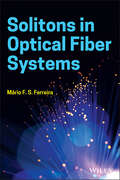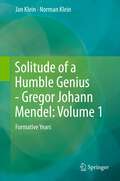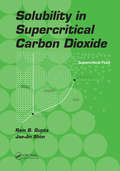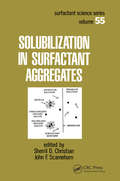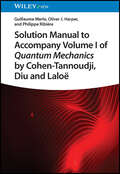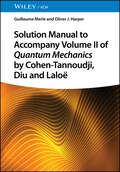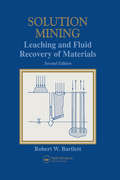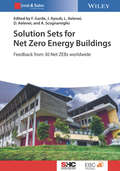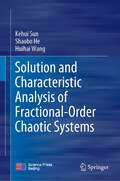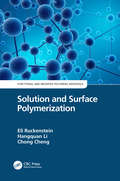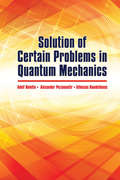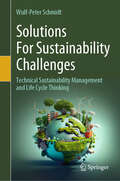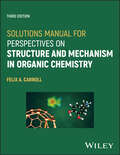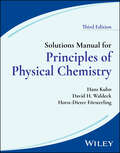- Table View
- List View
Solids and Liquids
by Lawrence Hall of Science University of California at Berkeley Delta EducationNIMAC-sourced textbook
Solids and Liquids
by Lawrence Hall of ScienceIntegrate reading and language arts in the context of science with original student books developed specifically to complement FOSS modules. Students extend and reinforce their classroom discoveries and vocabulary after their hands-on explorations of life, earth, and physical science concepts. Large, colorful photographs and appropriate text enhance the science learning experience.
Solids and Liquids
by The Editors at the University of California at BerkeleyExplores the properties of solids and liquids. Simple wording and everyday examples are used to help children better understand the differences.
Solids and Surfaces: A Chemist's View of Bonding in Extended Structures (Professional Reference Ser.)
by Roald HoffmannThis unique book shows how chemistry and physics come together in the solid state and on surfaces. Using a lively, graphic, descriptive approach, it teaches chemists the language that is necessary to understand the electronic structure of extended systems. And, at the same time, it demonstrates how a chemical, frontier-orbital, approach to solid state and surface bonding and reactivity may be constructed. The book begins with the language of crystal orbitals, band structures and densities of states. The tools for moving back from the highly delocalized orbitals of the solid are then built up in a transparent manner; they include decompositions of the densities of states and crystal orbital overlap populations. Using these tools, the book shapes a meeting ground between detailed quantum mechanical calculations and a chemical frontier orbital perspec- tive. Applications include a general picture of chemisorption, bond-breaking and making in the solid state, bonding in metals, the electronic structure of selected conducting and supercon- ducting structures, dissociation, migration and coupling on surfaces and the forces controlling deformation of extended systems.
Solids, Liquids And Gases
by John M. PattenAn educational look at solids, liquids, and gasses for kids.
Solids, Liquids, Guess Who's Got Gas?: Lucy's Lab #2 (Lucy?s Lab)
by Michelle Houts Elizabeth ZechelAutumn has arrived, and at Granite City Elementary School everyone is gearing up for the biggest and best event of the year: the Harvest Festival. The whole school is excited about the games, the contests, the food, and, most of all, the costumes! Everyone except Lucy. She doesn’t like dressing up, and has no desire to be a fairy princess or rock star, even for one day. But Lucy is excited about the new science unit Miss Flippo has started: the states of matter. Lucy and her friends understand solids and liquids. They’re easy. But gasses are more difficult to grasp. When the class goes on a field trip to an orchard and Stewart Swinefest eats too many apples, and gets a serious stomachache, Lucy suddenly understands that even if you can’t see gasses they can fill space and expand, and even make you move. And with Stewart feeling better, she has a really great idea for her Harvest Festival costume, too.The second book in a new chapter book series from IRA Children’s Book Award-winner, Michelle Houts, Solids, Liquids, Guess Who’s Got Gas draws on STEM themes and is aligned with curriculum guidelines to bring a love of science to young readers, inspiring them to start their own labs and explore their world.
Solid–Liquid Separation Technologies: Applications for Produced Water
by Olayinka I. OgunsolaThis book presents recent research and advances in various solid–liquid separation technologies and some applications for treating produced water. It covers fundamental principles and the importance of produced water in major industrial sectors and compares solid–liquid separation technologies. In addition, this book Presents the results of research studies conducted to evaluate the performance of solid–liquid separation technologies Discusses a wide range of technologies, including membrane, filtration, crystallization, desalination, supercritical fluids, coagulation, and floatation Includes experimental, theoretical, modeling, and process design studies With its comprehensive coverage, this book is an essential reference for chemical researchers, scientists, and engineers in industry, academia, and professional laboratories. It is also an important resource for graduate and advanced undergraduate students studying solid–liquid separations.
Solitary Waves Plasms Atmosph
by V.I. Petviashvili O.A. Pohkotelov O.A. PokhotelovFirst Published in 1992. Routledge is an imprint of Taylor & Francis, an informa company.
Soliton Coding for Secured Optical Communication Link
by Iraj Sadegh Amiri Sayed Ehsan Alavi Sevia Mahdaliza IdrusNonlinear behavior of light such as chaos can be observed during propagation of a laser beam inside the microring resonator (MRR) systems. This Brief highlights the design of a system of MRRs to generate a series of logic codes. An optical soliton is used to generate an entangled photon. The ultra-short soliton pulses provide the required communication signals to generate a pair of polarization entangled photons required for quantum keys. In the frequency domain, MRRs can be used to generate optical millimetre-wave solitons with a broadband frequency of 0-100 GHz. The soliton signals are multiplexed and modulated with the logic codes to transmit the data via a network system. The soliton carriers play critical roles to transmit the data via an optical communication link and provide many applications in secured optical communications. Therefore, transmission of data information can be performed via a communication network using soliton pulse carriers. A system known as optical multiplexer can be used to increase the channel capacity and security of the signals.
Solitonic Neural Networks: An Innovative Photonic Neural Network Based on Solitonic Interconnections (Machine Intelligence for Materials Science)
by Alessandro BileThis book delves into optics and photonic materials, describing the development of an intelligent all-optical system capable of replicating the functional building blocks of the biological brain. Starting with an analysis of biological neuronal dynamics and traversing the state of the art of neuromorphic systems developed to date, the book arrives at a description of neural networks realized through spatial soliton technology.After a brief introduction to the biology of neural networks (Chapter 1), the book delves into the description of the neuromorphic problem emphasizing the peculiarities of optical hardware developed to date. (Chapter 2). Chapter 3 is dedicated to the description of psychomemories , which represent the modeling of human learning according to the theories of modern neuro-psychology. This chapter provides the prerequisites for understanding how solitonic neural networks (SNNs) are able to learn and how they approach biological models. Chapter 4 focuses on the experimentation of solitonic optic neurons in thin layers of lithium niobate. Optical techniques for supervised and unsupervised learning are discussed. The entire chapter is accompanied by theoretical, simulative and experimental results. This chapter explains how an X-junction neuron is able to establish synapses, modify them, or erase them. The erasure of solitonic structures represents an important innovation in the field of nonlinear optics. Finally, Chapter 5 reports on the implementation of a network of neurons capable of processing information and storing it exactly as a human episodic memory does. The chapter ends with a number of insights into the lines of research that are currently being pursued on the basis of the results obtained.The book is meant for graduate students and researchers in the fields of optics, photonic applications, and biology. However, the main beneficiaries of this book are senior researchers in the field of nonlinear optics and artificial intelligence. To fully understand the results, it is important to have a basic knowledge of optical physics and neuron biology.
Solitons in Optical Fiber Systems
by Mario F. FerreiraSolitons in Optical Fiber Systems Discover a robust exploration of the main properties and behaviors of solitons in fiber systems In Solitons in Optical Fiber Systems, distinguished researcher Dr. Mário F. S. Ferreira delivers a thorough treatment of the main characteristics of solitons in optical fiber communication systems and fiber devices, paying special attention to stationary and pulsating dissipative soliton pulses. The book discusses the technical aspects associated with the physical background and the theoretical description of soliton characteristics under different conditions. The author employs numerical analyses and variational approaches to describe soliton evolution and describes the phenomenon of supercontinuum generation and various solitonic effects observed in highly nonlinear fibers, like photonic crystal fibers. Readers will learn about different applications of fiber solitons in transmission systems, fiber lasers, couplers, and pulse compression schemes, as well as complex Ginzburg-Landau equations, which are used to model different types of dissipative systems. The book also includes: A thorough introduction to solitons, including the linear and nonlinear effects of a wave, the discovery of solitary waves, and the discovery of solitons in optical fibers An exploration of fiber dispersion and nonlinearity, including optical fiber dispersion, the pulse propagation equation, and the impact of fiber dispersion Practical discussions of nonlinear effects in optical fibers, including self-phase modulation, cross-phase modulations, four-wave mixing, and stimulated raman scattering In-depth treatments of solitons in optical fibers, including modulation instability, dark solitons, bistable solitons, XPM-paired solitons, and the variational approach Perfect for senior undergraduate and graduate students in courses dealing with fiber-optics technology, Solitons in Optical Fiber Systems is also an ideal resource for engineers and technicians in the fiber-optics industry and researchers of nonlinear fiber optics.
Solitude of a Humble Genius - Gregor Johann Mendel: Formative Years
by Norman Klein Jan KleinGregor Johann Mendel continues to fascinate the general public as well as scholars, the former for his life and the latter for his achievements. Solitude of a Humble Genius is a two-volume biography presenting Mendel in the context of the history of biology and philosophy, and in the context of the setting in which he lived and worked. In this first volume the authors set the stage for a new interpretation of Mendel's achievements and personality. The period of Mendel's life covered by this volume is critical to understanding why he saw what other biologists, including Charles Darwin, for example, didn't. In searching for clues to Mendel's thinking, the authors discuss at length the origin of his genes; the history of the region of his birth; they also spend a day and then the four seasons of the year with his family; and finally they examine the schooling he received, as well as the cultural and political influences he was exposed to. An indispensible part of the work is Norman Klein's artwork. In this first volume alone, it comprises nearly 80 original drawings and includes cartoons that enliven the narration, scenes from Mendel's life, portraits, and plans and drawings of the cities and buildings in which he lived, studied, and worked.
Solomon's Code: Humanity In A World Of Thinking Machines
by Olaf Groth Mark NitzbergA thought-provoking examination of artificial intelligence and how it reshapes human values, trust, and power around the world. Whether in medicine, money, or love, technologies powered by forms of artificial intelligence are playing an increasingly prominent role in our lives. As we cede more decisions to thinking machines, we face new questions about staying safe, keeping a job and having a say over the direction of our lives. The answers to those questions might depend on your race, gender, age, behavior, or nationality. New AI technologies can drive cars, treat damaged brains and nudge workers to be more productive, but they also can threaten, manipulate, and alienate us from others. They can pit nation against nation, but they also can help the global community tackle some of its greatest challenges—from food crises to global climate change. In clear and accessible prose, global trends and strategy adviser Olaf Groth, AI scientist and social entrepreneur Mark Nitzberg, along with seasoned economics reporter Dan Zehr, provide a unique human-focused, global view of humanity in a world of thinking machines.
Solubility in Supercritical Carbon Dioxide
by Ram B. Gupta Jae-Jin ShimSupercritical fluid extraction is an environmentally safe and cost-effective alternative to traditional organic solvents. Carbon dioxide is widely used as the solvent of choice for applications such as caffeine and nicotine extraction due to its mild critical temperature, nontoxicity, nonflammability, and low cost. Introducing the most complete col
Solubilization in Surfactant Aggregates
by Sherril D. Christian and John F ScamehornThis work covers topics ranging from fundamental studies of solubilization to practical technological applications of the phenomenon. It reviews the solubilization of organic materials into surfactant aggregates, including micelles, vesicles and admicelles. The book also details methods of measuring solubilization that utilize both classical and newer instrumental techniques. It is intended for physical, surface, colloid and surfactant chemists; chemical, environmental and civil engineers; and upper-level undergraduate and graduate students in these disciplines.
Solution Manual to Accompany Volume I of Quantum Mechanics by Cohen-Tannoudji, Diu and Laloë
by Guillaume Merle Oliver J. Harper Philippe RibiereSolution Manual to Accompany Volume I of Quantum Mechanics by Cohen-Tannoudji, Diu and Laloë Grasp the fundamentals of quantum mechanics with this essential set of solutions Quantum mechanics, with its counter-intuitive premises and its radical variations from classical mechanics or electrodynamics, is both among the most important components of a modern physics education and one of the most challenging. It demands both a theoretical grounding and a grasp of mathematical technique that take time and effort to master. Students working through quantum mechanics curricula generally practice by working through increasingly difficult problem sets, such as those found in the seminal Quantum Mechanics volumes by Cohen-Tannoudji, Diu and Laloë. This solution manual accompanies Volume I and offers the long-awaited detailed solutions to all 69 problems in this text. Its accessible format provides explicit explanations of every step, focusing on both the physical theory and the formal mathematics, to ensure students grasp all pertinent concepts. It also includes guidance for transferring the solution approaches to comparable problems in quantum mechanics. Readers also benefit from: Approximately 70 figures to clarify key steps and concepts Detailed explanations of problems concerning quantum mechanics postulates, mathematical tools, properties of angular momentum, and more This solution manual is a must-have for students in physics, chemistry, or the materials sciences looking to master these challenging problems, as well as for instructors looking for pedagogical approaches to the subject.
Solution Manual to Accompany Volume II of Quantum Mechanics by Cohen-Tannoudji, Diu and Laloë
by Guillaume Merle Oliver J. HarperProvides detailed solutions to all 47 problems in the seminal textbook Quantum Mechanics, Volume II With its counter-intuitive premises and its radical variations from classical mechanics or electrodynamics, quantum mechanics is among the most important and challenging components of a modern physics education. Students tackling quantum mechanics curricula generally practice by working through increasingly difficult problem sets that demand both a theoretical grounding and a solid understanding of mathematical technique. Solution Manual to Accompany Volume II of Quantum Mechanics by Cohen-Tannoudji, Diu and Laloë is designed to help you grasp the fundamentals of quantum mechanics by doing. This essential set of solutions provides explicit explanations of every step, focusing on the physical theory and formal mathematics needed to solve problems with varying degrees of difficulty. Contains in-depth explanations of problems concerning quantum mechanics postulates, mathematical tools, approximation methods, and moreCovers topics including perturbation theory, addition of angular momenta, electron spin, systems of identical particles, time-dependent problems, and quantum scattering theoryGuides readers on transferring the solution approaches to comparable problems in quantum mechanicsIncludes numerous figures that demonstrate key steps and clarify key concepts Solution Manual to Accompany Volume II of Quantum Mechanics by Cohen-Tannoudji, Diu and Laloë is a must-have for students in physics, chemistry, or the materials sciences wanting to master these challenging problems, as well as for instructors looking for pedagogical approaches to the subject.
Solution Mining: Leaching and Fluid Recovery of Materials
by Robert BartlettFirst published in 1998. This book offers a wealth of information on the rapidly expanding field of solution mining: yhe extraction of materials from the earth by leaching and fluid recovery. This is an introductory text for students and professional engineers that is comprehensive and emphases current practice and theory. Percolation leaching of fragmented ground is covered, as well as true and modified in situ teaching. Solution mining of gold, copper and uranium ores, several slats extracted from evaporates and brines, and sulfur are discussed. Mineral teaching chemistry and kinetics, hydrology (including flow equations for various wellfields and other fluid recovery systems), environmental containment and solution mining simulation models are also included.
Solution Sets for Net Zero Energy Buildings: Feedback from 30 Buildings Worldwide (Solar Heating and Cooling)
by François GardeNet Zero-Energy Buildings have been the object of numerous studies in recent years as various countries have set this performance level as a long-term goal of their energy policies. This book presents a unique study of 30 NZEBs that have been constructed and have had their performance measured for at least 12 months. The study is based upon an international collaborative research initiated by the International Energy Agency - the Solar Heating and Cooling Programme (SHC). It is the first book to evaluate building strategies in houses, educational buildings and offices that have been demonstrated to work in practice. It examines how the design challenges of climate and building type have been addressed, and to what extent the various design approaches have been successful. This book presents convincing evidence that a careful re-thinking of conventional design norms can achieve a far greater performance benefit than is normally feasible. It identifies `solution sets? that work at the whole building level and at the individual building design challenge level for each climate and building type. In doing so, the book provides guidance as to how to improve the design by learning from these cases. Unusually for a book of this type it has examples of buildings in what are conventionally labeled "hot" and "cold" climates. A simple process is proposed for the reader to commission the analysis of their own climate to assess not only the conventional measure of how hot or cold or humid it is, but also to assess its suitability to support other NZEB technical challenge solutions sets such as Daylight or Natural Ventilation or comfort based climate conditioning.
Solution and Characteristic Analysis of Fractional-Order Chaotic Systems
by Kehui Sun Shaobo He Huihai WangThis book highlights the solution algorithms and characteristic analysis methods of fractional-order chaotic systems. Fractal dimensions exist broadly in the study of nature and the development of science and technology. Fractional calculus has become a hot research area in nonlinear science. Fractional-order chaotic systems are an important part of fractional calculus. The book discusses the numerical solution algorithms and characteristic analysis of fractional-order chaotic systems and introduces the techniques to implement the systems with circuits. To facilitate a quick grasp, the authors present examples from their years of work in the appendix. Intended for graduate students and researchers interested in chaotic systems, the book helps one to build a theoretical and experimental foundation for the application of fractional-order chaotic systems.
Solution and Surface Polymerization
by Eli Ruckenstein, Hangquan Li and Chong ChengComprising one volume of Functional and Modified Polymeric Materials, Two-Volume Set, this well-organized collection of papers by Professor Eli Ruckenstein and co-workers focuses on functional and modified polymeric materials prepared mainly through solution polymerization and surface polymerization. Although solution polymerization has been broadly utilized for the preparation of polymeric materials, the book shows significant approaches to special classes of polymeric materials including functional polymers by living ionic polymerization, degradable and decrosslinkable polymers, semi- and interpenetrating polymer network pervaporation membranes, and soluble conducting polymers. It also focuses on preparing and modifying conductive surface of polymer or polymer-based materials.
Solution of Certain Problems in Quantum Mechanics (Dover Books on Physics)
by A. Bolotin A. Pozamantir A. RaudeliunasIntended for advanced undergraduates and graduate students in mathematics, physics, and chemistry, this work teaches problem-solving using the theory of special functions. The concise treatment presents the theory methodically and in detail to a wide variety of problems in atomic and molecular physics. The overall applicability of this method and its extension to solving these problems are discussed with attention to detail seldom found in textbooks of this level.Starting with a brief introduction to the hypergeometric equations and their properties, a step-by-step method consisting of six distinct parts illustrates how to address typical problems in quantum physics in a simple and uniform fashion. This technique can also be applied to the solution of other problems, for which the Schrödinger equation can be reduced by some means to an equation of the hypergeometric type. Topics include the discrete spectrum eigenfunctions, linear harmonic oscillators, Kratzer molecular potential, and the rotational correction to the Morse formula. The text concludes with an Appendix that presents an original Fourier transform-based method for converting multicenter integrals to a single center.
Solutions For Sustainability Challenges: Technical Sustainability Management and Life Cycle Thinking
by Wulf-Peter SchmidtThe book is intended as a primary resource for Chief Sustainability Officers (CSOs), all professionals with interest in sustainability as well as sustainability courses at CBS International Business School and other universities. It starts by reviewing the challenges of sustainability (environmental, social, economic, and governance). The basics of life cycle thinking are explained, looking at Life Cycle Assessment/LCA, Life Cycle Costing/LCC, Social LCAs, and Life Cycle Management. These are applied to sustainable strategy development, sustainable product development, sustainable supply chain management and logistics, sustainable production, sustainable consumption, circular economy, sustainable digitalization, sustainable finance, sustainable employee relations, sustainable advocacy, law and policymaking, etc.—to show how each person in each profession and role can act sustainably and how to democratize sustainability.
Solutions Manual for Perspectives on Structure and Mechanism in Organic Chemistry
by Felix A. CarrollSOLUTIONS MANUAL FOR PERSPECTIVES ON STRUCTURE AND MECHANISM IN ORGANIC CHEMISTRY Based on the author’s first-hand classroom experience, this solutions manual complements the 3rd edition of Perspectives on Structure and Mechanism in Organic Chemistry. The solutions to the 438 textbook problems help students increase their understanding of physical organic chemistry, and more than 550 references stimulate their engagement with the chemical literature.
Solutions Manual for Principles of Physical Chemistry, 3rd Edition, Solutions Manual
by Hans Kuhn Horst-Dieter Försterling David H. WaldeckThis is a Solutions Manual to Accompany with solutions to the exercises in the main volume of Principles of Physical Chemistry, Third Edition. This book provides a unique approach to introduce undergraduate students to the concepts and methods of physical chemistry, which are the foundational principles of Chemistry. The book introduces the student to the principles underlying the essential sub-fields of quantum mechanics, atomic and molecular structure, atomic and molecular spectroscopy, statistical thermodynamics, classical thermodynamics, solutions and equilibria, electrochemistry, kinetics and reaction dynamics, macromolecules, and organized molecular assemblies. Importantly, the book develops and applies these principles to supramolecular assemblies and supramolecular machines, with many examples from biology and nanoscience. In this way, the book helps the student to see the frontier of modern physical chemistry developments. The book begins with a discussion of wave-particle duality and proceeds systematically to more complex chemical systems in order to relate the story of physical chemistry in an intellectually coherent manner. The topics are organized to correspond with those typically given in each of a two course semester sequence. The first 13 chapters present quantum mechanics and spectroscopy to describe and predict the structure of matter: atoms, molecules, and solids. Chapters 14 to 29 present statistical thermodynamics and kinetics and applies their principles to understanding equilibria, chemical transformations, macromolecular properties and supramolecular machines. Each chapter of the book begins with a simplified view of a topic and evolves to more rigorous description, in order to provide the student (and instructor) flexibility to choose the level of rigor and detail that suits them best. The textbook treats important new directions in physical chemistry research, including chapters on macromolecules, principles of interfaces and films for organizing matter, and supramolecular machines -- as well as including discussions of modern nanoscience, spectroscopy, and reaction dynamics throughout the text.

